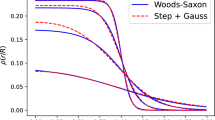Abstract
The shape of atomic nuclei is often interpreted to possess a quadrupole deformation that fluctuates around some average profile. We investigate the impact of nuclear shape fluctuations on the initial state geometry in heavy ion collisions, particularly its eccentricity \(\varepsilon _2\) and inverse size \(d_{\perp }\), which can be related to the elliptic and radial flow in the final state. The fluctuation in overall quadrupole deformation enhances the variances and modifies the skewness and kurtosis of the \(\varepsilon _2\) and \(d_{\perp }\) in a controllable manner. The fluctuation in triaxiality reduces the difference between prolate and oblate shape for any observable, whose values, in the large fluctuation limit, approach those obtained in collisions of rigid triaxial nuclei. The method to disentangle the mean and variance of the quadrupole deformation is discussed.










Similar content being viewed by others
Data availability
The manuscript has associated data in a data repository [Authors’ comment: Data are available upon request.]
Notes
Random fluctuations of nucleon position in Glauber model naturally induce a small quadrupole deformation [24], which is subtracted and does not impact our discussion.
References
W. Busza, K. Rajagopal, W. van der Schee, Ann. Rev. Nucl. Part. Sci. 68, 339 (2018). https://doi.org/10.1146/annurev-nucl-101917-020852. arXiv:1802.04801 [hep-ph]
J.E. Bernhard, J.S. Moreland, S.A. Bass, J. Liu, U. Heinz, Phys. Rev. C 94, 024907 (2016). https://doi.org/10.1103/PhysRevC.94.024907. arXiv:1605.03954 [nucl-th]
G. Giacalone (2022). arXiv:2208.06839 [nucl-th]
P. Ring, P. Schuck, The Nuclear Many-Body Problem
P. Möller, A.J. Sierk, T. Ichikawa, H. Sagawa, Atom. Data Nucl. Data Tabl. 109–110, 1 (2016). https://doi.org/10.1016/j.adt.2015.10.002. arXiv:1508.06294 [nucl-th]
G. Scamps, S. Goriely, E. Olsen, M. Bender, W. Ryssens, Eur. Phys. J. A 57, 333 (2021). https://doi.org/10.1140/epja/s10050-021-00642-1. arXiv:2011.07904 [nucl-th]
J. Jia, C.-J. Zhang, Phys. Rev. C 107, L021901 (2023). https://doi.org/10.1103/PhysRevC.107.L021901. arXiv:2111.15559 [nucl-th]
G. Nijs, W. van der Schee (2021). arXiv:2112.13771 [nucl-th]
J. Jia, G. Giacalone, C. Zhang, (2022). arXiv:2206.10449 [nucl-th]
M. Abdallah et al. (STAR), Phys. Rev. C 105, 014901 (2022). https://doi.org/10.1103/PhysRevC.105.014901. arXiv:2109.00131 [nucl-ex]
H. Xu, C. Zhang (STAR Collabration), Constraints on neutron skin thickness and nuclear deformations using relativistic heavy-ion collisions from STAR (2022). https://indico.cern.ch/event/895086/contributions/4724887/. https://indico.cern.ch/event/895086/contributions/4749420/
C. Zhang, S. Bhatta, J. Jia, Phys. Rev. C 106, L031901 (2022). https://doi.org/10.1103/PhysRevC.106.L031901. arXiv:2206.01943 [nucl-th]
C. Zhang, J. Jia, Phys. Rev. Lett. 128, 022301 (2022). https://doi.org/10.1103/PhysRevLett.128.022301. arXiv:2109.01631 [nucl-th]
Y. Cao, S.E. Agbemava, A.V. Afanasjev, W. Nazarewicz, E. Olsen, Phys. Rev. C 102, 024311 (2020). https://doi.org/10.1103/PhysRevC.102.024311. arXiv:2004.01319 [nucl-th]
B. Bally et al., (2022). arXiv:2209.11042 [nucl-ex]
M. Bender, P.-H. Heenen, P.-G. Reinhard, Rev. Mod. Phys. 75, 121 (2003). https://doi.org/10.1103/RevModPhys.75.121
M. Bender, P.-H. Heenen, Phys. Rev. C 78, 024309 (2008). https://doi.org/10.1103/PhysRevC.78.024309. arXiv:0805.4383 [nucl-th]
T.R. Rodriguez, J.L. Egido, Phys. Rev. C 81, 064323 (2010). https://doi.org/10.1103/PhysRevC.81.064323. arXiv:1004.2877 [nucl-th]
K. Heyde, J.L. Wood, Rev. Mod. Phys. 83, 1467 (2011). https://doi.org/10.1103/RevModPhys.83.1467
K. Kumar, Phys. Rev. Lett. 28, 249 (1972). https://doi.org/10.1103/PhysRevLett.28.249
A. Poves, F. Nowacki, Y. Alhassid, Phys. Rev. C 101, 054307 (2020). https://doi.org/10.1103/PhysRevC.101.054307. arXiv:1906.07542 [nucl-th]
J. Jia, Phys. Rev. C 105, 014905 (2022). https://doi.org/10.1103/PhysRevC.105.014905. arXiv:2106.08768 [nucl-th]
D. Teaney, L. Yan, Phys. Rev. C 83, 064904 (2011). https://doi.org/10.1103/PhysRevC.83.064904. arXiv:1010.1876 [nucl-th]
B.G. Zakharov, JETP Lett. 112, 393 (2020). https://doi.org/10.1134/S0021364020190029. arXiv:2008.07304 [nucl-th]
B.G. Zakharov, J. Exp. Theor. Phys. 134, 669 (2022). https://doi.org/10.1134/S1063776122050077. arXiv:2112.06066 [nucl-th]
J. Jia, Phys. Rev. C 105, 044905 (2022). https://doi.org/10.1103/PhysRevC.105.044905. arXiv:2109.00604 [nucl-th]
C. Loizides, Phys. Rev. C 94, 024914 (2016). https://doi.org/10.1103/PhysRevC.94.024914. arXiv:1603.07375 [nucl-ex]
M. Zhou, J. Jia, Phys. Rev. C 98, 044903 (2018). https://doi.org/10.1103/PhysRevC.98.044903. arXiv:1803.01812 [nucl-th]
P. Bozek, Phys. Rev. C 93, 044908 (2016). https://doi.org/10.1103/PhysRevC.93.044908. arXiv:1601.04513 [nucl-th]
Acknowledgements
This research is supported by DOE DE-FG02-87ER40331.
Author information
Authors and Affiliations
Corresponding author
Additional information
Communicated by Vittorio Somà.
Appendix
Appendix
The default results in this paper are obtained with the nucleon Glauber model. We have repeated the analysis for the quark Glauber model and compared it with the nucleon Glauber model results in Figs. 9 and 10 for the impact of \(\gamma \) fluctuation and \(\beta \) fluctuation, respectively. The trends are mostly very similar. A few exceptions are observed. In particular, the results of the two models are shifted vertically from each other in Fig. 9. In the case of \(\beta \) fluctuation in Fig. 10, the variance \(c_{\textrm{d}}\{2\}\) and skewness \(c_{\textrm{d}}\{3\}\) are systematically different between the two models in the high \({\bar{\beta }}\) region. Table 2 gives the cumulant expression for the case where the projectile and target nuclei have the same mass number but different deformations. These expressions are expected from the additive nature of the cumulants.
The values of \(\left\langle \varepsilon _2^4\right\rangle -K\left\langle \varepsilon _2^2\right\rangle ^2\) for the value of K that minimize the dependence on \(\sigma _{\beta }\) in the quark Glauber model, similar to Fig. 6
Rights and permissions
Springer Nature or its licensor (e.g. a society or other partner) holds exclusive rights to this article under a publishing agreement with the author(s) or other rightsholder(s); author self-archiving of the accepted manuscript version of this article is solely governed by the terms of such publishing agreement and applicable law.
About this article
Cite this article
Dimri, A., Bhatta, S. & Jia, J. Impact of nuclear shape fluctuations in high-energy heavy ion collisions. Eur. Phys. J. A 59, 45 (2023). https://doi.org/10.1140/epja/s10050-023-00965-1
Received:
Accepted:
Published:
DOI: https://doi.org/10.1140/epja/s10050-023-00965-1





